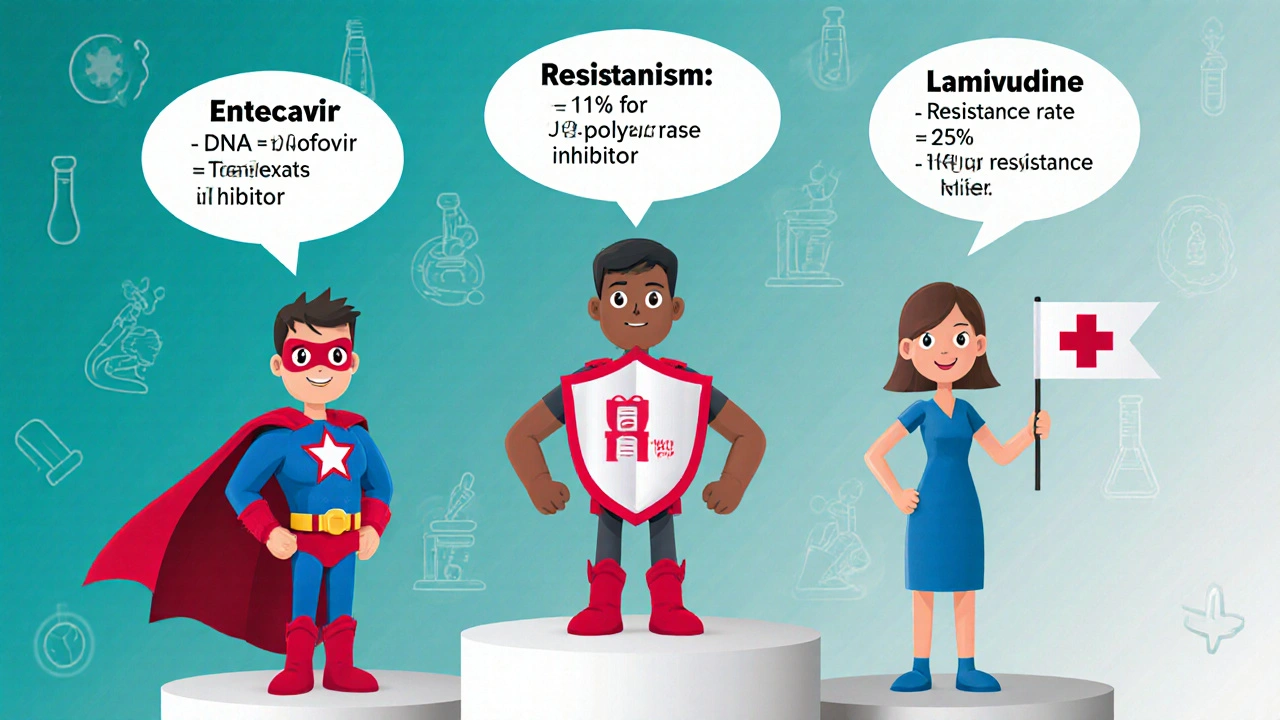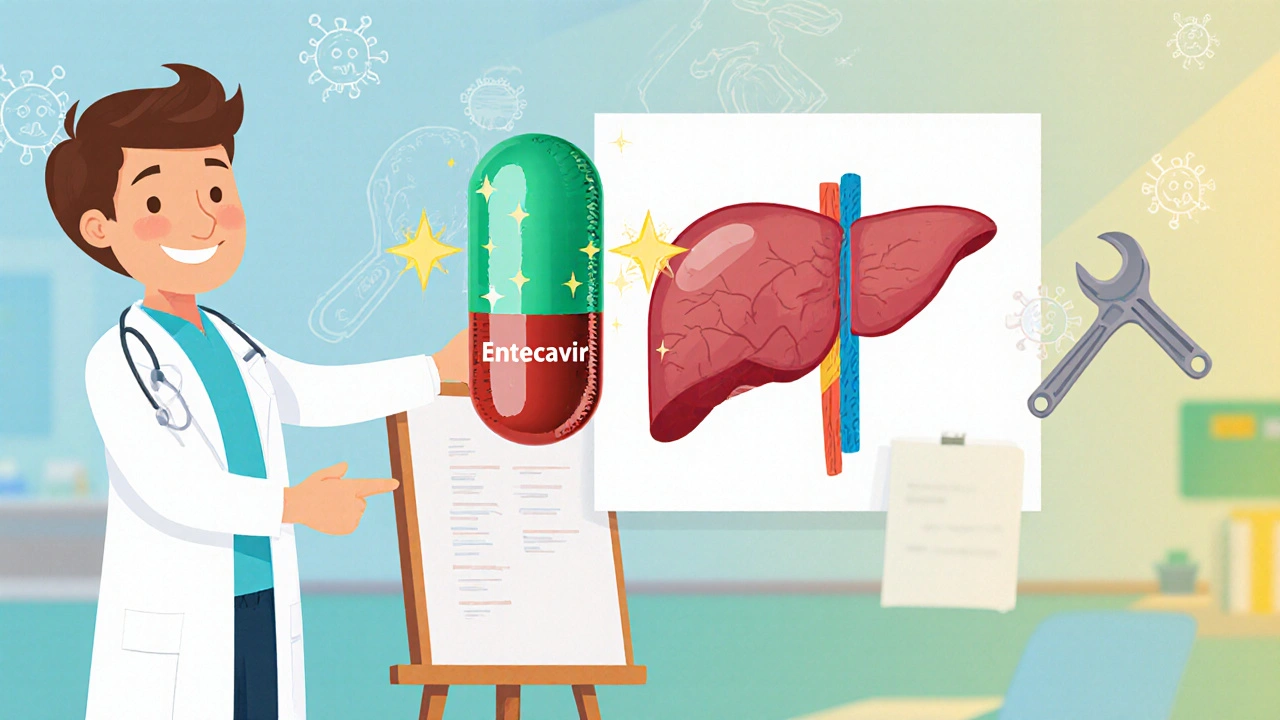Hepatitis B Treatment Comparison Tool
First-Line Hepatitis B Treatments
Select a treatment to learn more about its specific characteristics and benefits for chronic hepatitis B management.
Entecavir
Tenofovir
Lamivudine
Key Takeaway
The choice of treatment depends on individual factors including treatment history, kidney function, pregnancy status, and resistance profile. Always consult with a healthcare professional for personalized recommendations.
Key Takeaways
- Entecavir is a nucleoside‑analog antiviral that blocks hepatitis B virus replication.
- It is one of three first‑line oral drugs recommended for chronic HBV in Australia.
- Understanding viral load, resistance patterns, and side‑effects helps patients stay on therapy.
- Community education can shrink stigma and boost vaccination rates.
- Trusted resources like the TGA, WHO and local hepatitis B support groups provide up‑to‑date guidance.
When you hear the word Entecavir, you might picture a tiny pill, but behind it sits a powerful tool in the fight against chronic hepatitis B (HBV). This article walks you through what HBV is, why treatment matters, how entecavir fits alongside other medicines, and practical ways you can help spread accurate information in your community.
What Is Hepatitis B?
Hepatitis B is a viral infection that targets the liver, caused by the hepatitis B virus (HBV). People can contract HBV through blood, sexual contact, or from mother to child at birth. While many clear the virus within six months, about 5‑10% develop a chronic infection that can progress to cirrhosis or liver cancer over decades.
Key markers doctors watch are the surface antigen (HBsAg), which signals infection, and the viral load (HBV DNA), which measures how many virus particles are circulating. High viral load often means a greater risk of liver damage, making antiviral therapy a critical part of long‑term management.
How Entecavir Works
Entecavir is a potent nucleoside analog antiviral medication that suppresses hepatitis B virus replication by inhibiting the viral DNA polymerase. Think of it as a wrench thrown into the virus’s assembly line - the drug mimics a natural building block of DNA, gets incorporated into the virus’s genome, and then halts further replication.
The drug is taken once daily, usually 0.5 mg for treatment‑naïve adults, and has a high genetic barrier to resistance. In large clinical trials, over 90% of patients achieved undetectable viral loads after five years of continuous therapy.

Comparing First‑Line Oral Therapies
| Drug | Mechanism | Resistance (5‑yr) | Typical Dose | Common Side‑effects |
|---|---|---|---|---|
| Entecavir | Nucleoside analog, DNA‑polymerase inhibitor | ~1 % (treatment‑naïve) | 0.5 mg daily | Headache, mild fatigue |
| Tenofovir disoproxil fumarate (TDF) | Nucleotide analog, DNA‑polymerase inhibitor | <1 % (high barrier) | 300 mg daily | Kidney function changes, bone density loss |
| Lamivudine | Nucleoside analog, DNA‑polymerase inhibitor | Up to 25 % after 5 yr | 100 mg daily | Diarrhoea, nausea |
In Australia, the Therapeutic Goods Administration (Therapeutic Goods Administration) lists both entecavir and tenofovir as first‑line options because of their low resistance rates and strong viral suppression. Lamivudine is now reserved for special cases where cost is a major barrier.
Who Benefits Most From Entecavir?
Ideal candidates include:
- Adults with confirmed chronic HBV (HBsAg positive >6 months) and elevated viral load.
- Patients with early‑stage liver fibrosis who need long‑term suppression.
- Individuals who have previously taken lamivudine and developed resistance - entecavir’s high barrier makes it a good rescue option.
Pregnant women are generally steered toward tenofovir because safety data for entecavir in pregnancy remain limited. Always check the latest guidance from the World Health Organization and your local health department.
Managing Side‑effects and Staying Adherent
Most people tolerate entecavir well, but a few experience mild headaches or fatigue. If symptoms linger, a quick chat with a pharmacist can identify simple fixes - staying hydrated, taking the pill with food, or adjusting the time of day.
Adherence is the biggest predictor of success. Set a daily alarm, use a pill‑box, or link the dose to a routine activity like brushing teeth. Telehealth check‑ins every three months help catch any lab changes early, keeping liver enzymes and viral load in the safe zone.

Raising Public Awareness: Practical Steps
Now that you understand the science, how can you help others?
- Start conversations. Share a personal story or a simple fact - “Did you know that one in three people with chronic HBV doesn’t know they’re infected?”
- Leverage social media. Post infographics that demystify terms like viral load and resistance. Tag reputable sources like the Australian Department of Health.
- Partner with local clinics. Offer to host a short Q&A session about HBV testing and treatment options, highlighting entecavir’s role.
- Distribute printed flyers. Many community centres still rely on paper handouts. Include a clear call‑to‑action: “Get tested at your nearest health service.”
- Support vaccination drives. While treatment manages existing infection, vaccination prevents new cases. Encourage schools and workplaces to offer the hepatitis B vaccine.
Each small action builds a ripple effect, turning stigma into knowledge and encouraging more people to seek testing.
Resources and Support Networks
Trusted information hubs include:
- The World Health Organization hepatitis B fact sheets.
- The Australian Therapeutic Goods Administration medication database.
- Local hepatitis B support groups such as Hepatitis B Foundation Australia.
- Pharmacy‑led medication review services, which can help you manage side‑effects and refill schedules.
Keeping these links handy makes it easier to answer questions as they arise, and it shows you’re speaking from a place of authority.
Frequently Asked Questions
Can I stop taking entecavir once my viral load is undetectable?
No. Chronic HBV usually requires lifelong suppression. Stopping the drug can lead to viral rebound and liver inflammation.
Is entecavir safe for people with kidney disease?
Entecavir is generally safe, but dose adjustment may be needed for severe renal impairment. Your doctor will check kidney function before prescribing.
How does entecavir compare to tenofovir in terms of resistance?
Both have very low resistance rates (<1 %). Tenofovir has a slightly stronger barrier, but entecavir’s efficacy is comparable for most patients.
Do I need regular blood tests while on entecavir?
Yes. Doctors typically check liver enzymes, HBV DNA levels, and kidney function every 3-6 months to ensure the medication is working and staying safe.
Can children take entecavir?
Entecavir is approved for children 2 years and older, but dosing is weight‑based and must be managed by a pediatric hepatologist.


Bradley Allan
October 21, 2025 AT 20:01Oh, the sheer power of Entecavir!; it’s like a superhero in a tiny capsule, bursting onto the battlefield of hepatitis B with an unstoppable force, preventing the virus from replicating-yes, you heard that right-blocking its very DNA polymerase!; Imagine the virus as a relentless factory, and Entecavir as a wrench thrown into its gears, halting production, stopping the spread, and saving countless lives!; The clinical trials? Over 90% of patients achieving undetectable viral loads after five years-unbelievable, right?; And let’s not forget the high genetic barrier to resistance, a fortress against mutating foes!; It’s prescribed once daily, simple as a morning coffee, yet its impact is profound-liver health preserved, fibrosis slowed, chances of cirrhosis reduced!; The side‑effects? Mere headaches and mild fatigue, far outweighed by the benefit of lifelong viral suppression!; Doctors watch markers like HBsAg and HBV DNA, and with Entecavir, these numbers dive dramatically, giving patients hope!; The drug fits snugly among other first‑line therapies, standing tall beside tenofovir and lamivudine, each with its own story, but Entecavir’s narrative is one of resilience!; For pregnant women, caution remains, but for the rest of us, it’s a beacon of treatment continuity!; Community education amplifies its reach-when people know that a daily pill can quell a silent killer, stigma fades!; Vaccination remains crucial, yet for those already infected, Entecavir is the lifeline they need!; Real‑world adherence tricks-alarms, pill‑boxes, linking to brushing teeth-turn medical advice into daily habit!; Telehealth follow‑ups every three months catch any lab changes early, ensuring the liver stays in the safe zone!; So, raise your voice, share this knowledge, because knowledge is the most potent medicine of all!;
brandon lee
October 22, 2025 AT 18:14Great rundown! It's good to see how Entecavir fits in the bigger picture. Keep spreading the word.
Joshua Pisueña
October 23, 2025 AT 16:27Entecavir is a solid option for HBV, especially with its low resistance. Take it daily and stay consistent.
Jhoan Farrell
October 24, 2025 AT 14:41💪 Stay on track with your meds, it really makes a difference 😌.
Eddie Mark
October 25, 2025 AT 12:54Yo, this stuff is fire-Entecavir’s like the quiet hero in the HBV saga, low side‑effects, high payoff. It’s the kind of medicine that doesn’t need a spotlight, but it totally saves the day when you’re consistent. Keep the vibes positive and the doses steady.
Rob Flores
October 26, 2025 AT 10:07Ah, the ever‑glorious Entecavir-because why settle for mediocrity when you can have a drug that’s *almost* perfect? Delightful, really.
Shiv Kumar
October 27, 2025 AT 08:21From a pharmacological standpoint, Entecavir’s mechanism is undeniably sophisticated, offering a commendable balance between efficacy and tolerability, which merits recognition within the therapeutic arsenal.
Ryan Spanier
October 28, 2025 AT 06:34Indeed, the clinical data support its use, and I encourage patients to engage with their healthcare providers to ensure proper monitoring. A disciplined adherence regimen, coupled with regular laboratory assessments, will optimize outcomes.
Abhinav Moudgil
October 29, 2025 AT 04:47Entecavir shines as a cornerstone therapy, especially for those with prior lamivudine exposure; its high genetic barrier offers a reassuring safety net. Patients should be reminded to maintain routine check‑ups and discuss any renal concerns with their clinicians.
Miah O'Malley
October 30, 2025 AT 03:01One might ponder the deeper implications of a society that embraces such medical marvels; do we not, in fact, elevate our collective consciousness when we champion both prevention and treatment? The dialogue between science and humanity continues.
Kyle Garrity
October 31, 2025 AT 01:14I hear you on the importance of staying on therapy-missing doses can feel like a setback, but remember, every day you take Entecavir you’re nudging the virus further away. It’s okay to feel frustrated, but you’re not alone in this journey.
Ralph Barcelos de Azevedo
October 31, 2025 AT 23:27Neglecting medication is not just a personal risk; it’s a moral failing when community health depends on each individual’s commitment. We must uphold responsibility.
Peter Rupar
November 1, 2025 AT 21:41dont quit just cuz a lil headache shows up, u cant be wuss about it!
Nikita Shue
November 2, 2025 AT 19:54Listen, if you’re serious about beating HBV, stick to the schedule-no excuses.
Stephen Wunker
November 3, 2025 AT 18:07Ah, but what if the very act of strict adherence is just another societal construct urging conformity? Perhaps we should question the narrative entirely.